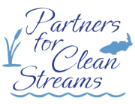 What do our many programs have in common? They focus on removing or preventing marine debris: human-created materials that find their way into our waterways, either deliberately or accidentally. Learn more about where marine debris comes from, and how you can join the fight against trash in our waterways.
What do our many programs have in common? They focus on removing or preventing marine debris: human-created materials that find their way into our waterways, either deliberately or accidentally. Learn more about where marine debris comes from, and how you can join the fight against trash in our waterways.
Marine debris comes in many shapes, sizes, and forms. Those of you who have joined us for Clean Your Streams Day or Get the Lead Out already know this to be true. Everything from foam coffee cups, to aluminum cans, to plastic grocery bags, to shopping carts, to tires – even sunken boats! – are all considered marine debris. Some of the toughest forms of marine debris to remove from the environment the smallest: tiny plastics like microbeads, pellets, and fibers.
What are some everyday ways you can reduce waterway pollution? Here are some of our favorite tips:
- Say no to straws in your drinks! Straws from restaurants and fast food cups are found in waterways all over the world. You probably don’t drink from a straw at home, why do it at a restaurant?
- Use reusable grocery bags. Plastic bags are by far one of the most commonly found items in our watershed clean-ups.
- Look for cardboard packaging at grocery stores or bulk found sellers instead of plastic packaging. Cardboard is more easily recycled and decomposes faster. Buying items in bulk not only cuts down on excess packaging, but also saves you money.
- Try non-toxic cleaning supplies, soap, and lotion or cleaning supplies that come in minimal packaging.
- If you are a smoker, be a responsible smoker. Carry a pocket ash-tray with you and be sure to dispose of the contents in the trash.
Have you checked out our Marine Debris 101 resources? We’ve got lots more information on the sources of marine debris, its impact on our waterways, and how you can help.
